It looks like you're using an Ad Blocker.
Please white-list or disable AboveTopSecret.com in your ad-blocking tool.
Thank you.
Some features of ATS will be disabled while you continue to use an ad-blocker.
20
share:
The legend of the Piasa bird, or the Bird That Devours Men was first recorded in 1673. Father Jacques Marquette, who was a French Jesuit missionary
and an early explorer of the northern portion of the Mississippi River Valley saw a painting on a limestone bluff overlooking the Mississippi River
near Alton, Illinois while exploring the area. He recorded the following description:
“While skirting some rocks, which by their height and length inspired awe, we saw upon one of them two painted monsters which at first made us afraid, and upon which the boldest savages dare not long rest their eyes. They are as large as a calf; they have horns on their heads like those of a deer, a horrible look, red eyes, a beard like a tiger’s, a face somewhat like a man’s, a body covered with scales, and so long a tail that it winds all around the body, passing above the head and going back between the legs, ending in a fish’s tail. Green, red and black are the three colors composing the picture. Moreover, these two monsters are so well painted that we cannot believe that any savage is their author; for good painters in France would find it difficult to reach that place conveniently to paint them. Here is approximately the shape of these monsters, as we have faithfully copied it.”
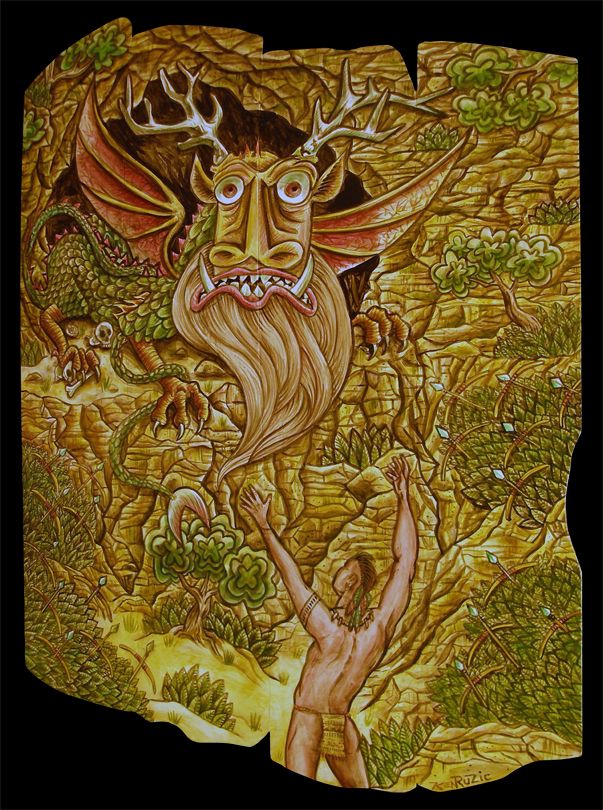
The monster depicted in the mural was first referred to as the “Piasa Bird” in an article published c. 1836 by John Russell of Bluffdale, Illinois. According to the story published by Russell, the creature depicted by the painting was a huge bird that lived in the cliffs. It was the local legend that this creature would attack and devour people in the nearby Indian villages shortly after slain bodies of a minor war gave it a taste for human flesh. The story goes on to say that a local Indian chief, named Chief Ouatoga, managed to slay the monster using a plan given to him in a dream from the Great Spirit. The chief ordered 20 of his bravest warriors to hide near the entrance of the Piasa Bird’s cave. Ouatoga then acted as bait to lure the creature out into the open. As the monster flew down toward the Indian chief, his warriors slew it with a volley of poisoned arrows. Thus ending the reign of the bird that devoured men.
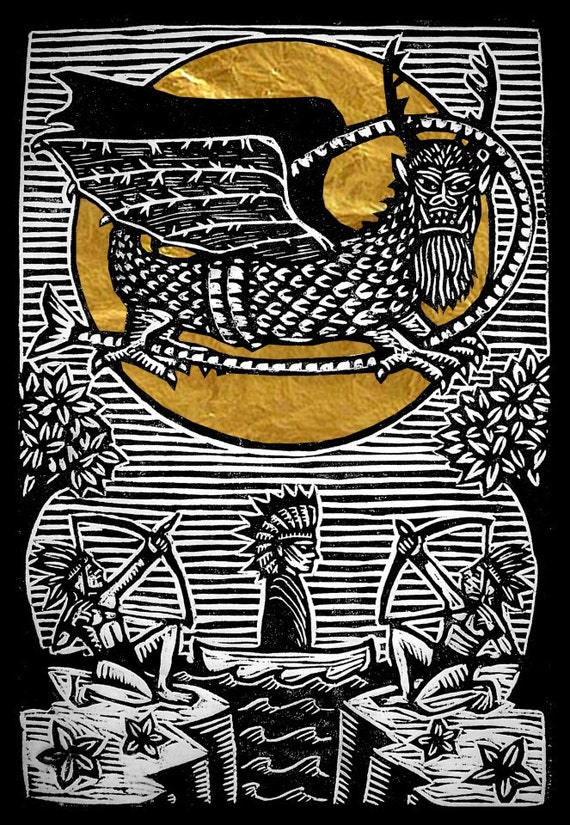
It’s possible that the mural was first painted before 1200 CE, at the height of Cahokia to the south. Cahokia was a city of 20,000 people of the Mississippian culture, best known for their mound building. The icons they created are found on everything from carvings to pottery, and quite often include Thunderbirds, bird men, gigantic snakes and other creatures. It’s thought that the painting at Alton was to identify this stretch of the river as being under their control, a warning if you will.
The original location of the mural was at the end of a chain of limestone bluffs in Madison County, Illinois at present-day Alton, Illinois. The original Piasa illustration no longer exists, but a newer 20th-century version, based partly on 19th-century sketches and lithographs, has been placed on a bluff in Alton, Illinois, several hundred yards upstream from its origin. Because the quality of the limestone rock is unsuited for preserving an image for very long, the painting must be regularly restored.
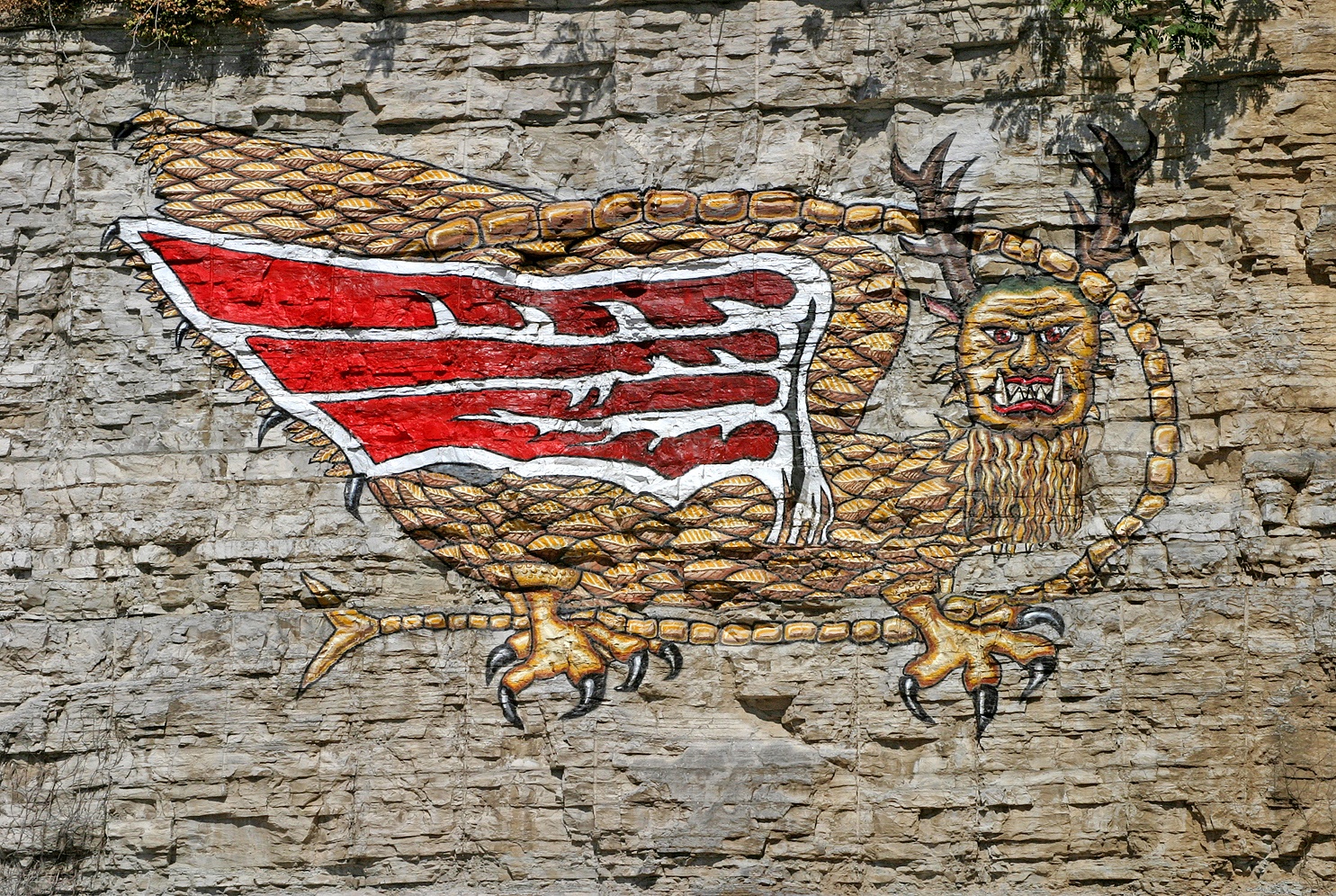
But was it ever thought to be a real creature, and could it exist today? Did giant birds once fly high over Alton and Cahokia? In the summer of 1977, a boy in Lawndale, Illinois, was reportedly snatched from the ground and carried thirty feet by a large bird, before the boy’s mother managed to beat the bird into letting her boy go.
“While skirting some rocks, which by their height and length inspired awe, we saw upon one of them two painted monsters which at first made us afraid, and upon which the boldest savages dare not long rest their eyes. They are as large as a calf; they have horns on their heads like those of a deer, a horrible look, red eyes, a beard like a tiger’s, a face somewhat like a man’s, a body covered with scales, and so long a tail that it winds all around the body, passing above the head and going back between the legs, ending in a fish’s tail. Green, red and black are the three colors composing the picture. Moreover, these two monsters are so well painted that we cannot believe that any savage is their author; for good painters in France would find it difficult to reach that place conveniently to paint them. Here is approximately the shape of these monsters, as we have faithfully copied it.”

The monster depicted in the mural was first referred to as the “Piasa Bird” in an article published c. 1836 by John Russell of Bluffdale, Illinois. According to the story published by Russell, the creature depicted by the painting was a huge bird that lived in the cliffs. It was the local legend that this creature would attack and devour people in the nearby Indian villages shortly after slain bodies of a minor war gave it a taste for human flesh. The story goes on to say that a local Indian chief, named Chief Ouatoga, managed to slay the monster using a plan given to him in a dream from the Great Spirit. The chief ordered 20 of his bravest warriors to hide near the entrance of the Piasa Bird’s cave. Ouatoga then acted as bait to lure the creature out into the open. As the monster flew down toward the Indian chief, his warriors slew it with a volley of poisoned arrows. Thus ending the reign of the bird that devoured men.

It’s possible that the mural was first painted before 1200 CE, at the height of Cahokia to the south. Cahokia was a city of 20,000 people of the Mississippian culture, best known for their mound building. The icons they created are found on everything from carvings to pottery, and quite often include Thunderbirds, bird men, gigantic snakes and other creatures. It’s thought that the painting at Alton was to identify this stretch of the river as being under their control, a warning if you will.
The original location of the mural was at the end of a chain of limestone bluffs in Madison County, Illinois at present-day Alton, Illinois. The original Piasa illustration no longer exists, but a newer 20th-century version, based partly on 19th-century sketches and lithographs, has been placed on a bluff in Alton, Illinois, several hundred yards upstream from its origin. Because the quality of the limestone rock is unsuited for preserving an image for very long, the painting must be regularly restored.

But was it ever thought to be a real creature, and could it exist today? Did giant birds once fly high over Alton and Cahokia? In the summer of 1977, a boy in Lawndale, Illinois, was reportedly snatched from the ground and carried thirty feet by a large bird, before the boy’s mother managed to beat the bird into letting her boy go.
Some of the other articles in this series can be found here:
The Tuttle Bottoms Monster
The Cole Hollow Road Monster
The Enfield Horror
The Tuttle Bottoms Monster
The Cole Hollow Road Monster
The Enfield Horror
a reply to: TrulyColorBlind
Reminds me of this a little:
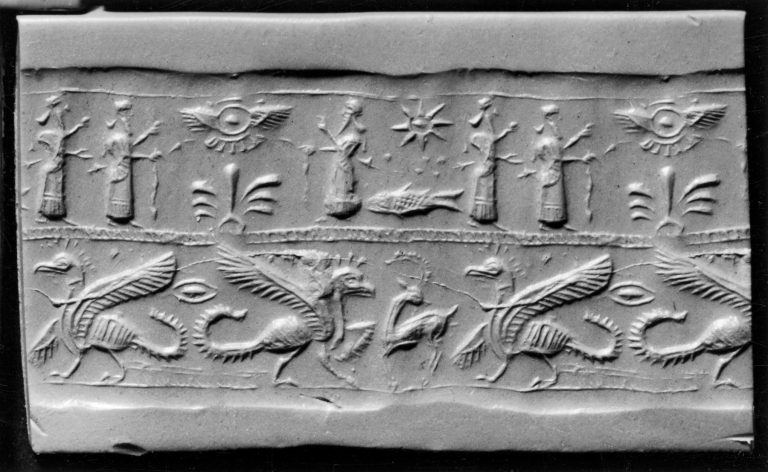
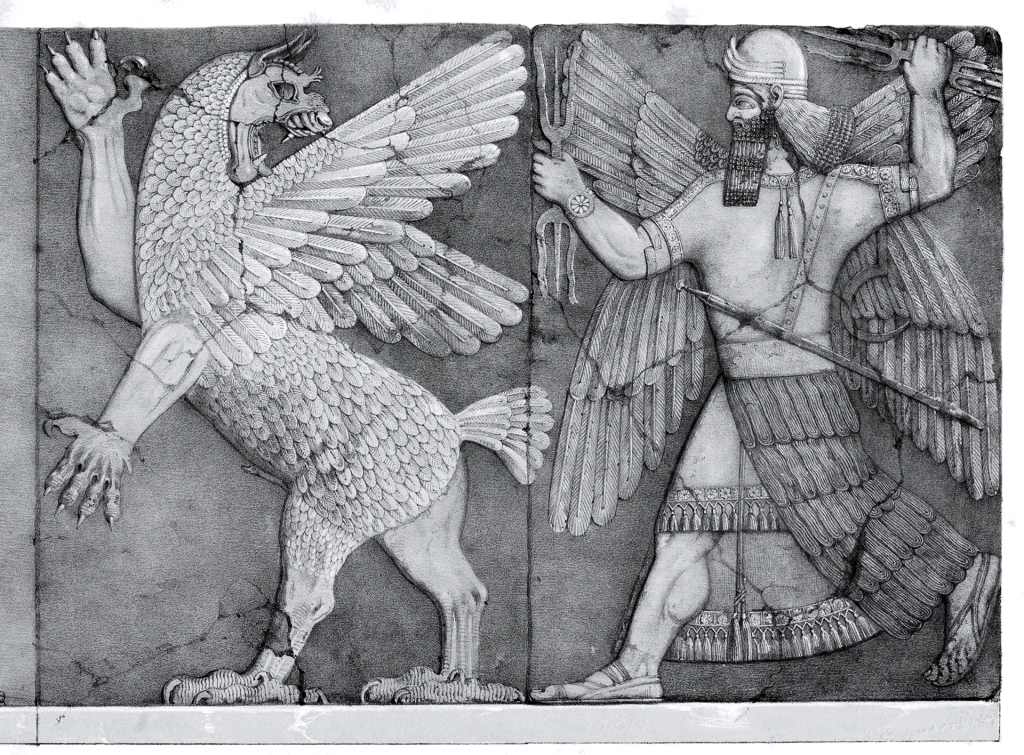
Reminds me of this a little:


edit on 25102021 by Wide-Eyes because: Add image.
That looks remarkably like a Dragon.
Strange to me, is apart from the 4 legs, they look very similar to Chinese Dragons. Even the face is quite similar.
Legend has it that Dragons could change their form at will. I wish our true history was available but that too has been ripped from us.
P
Strange to me, is apart from the 4 legs, they look very similar to Chinese Dragons. Even the face is quite similar.
Legend has it that Dragons could change their form at will. I wish our true history was available but that too has been ripped from us.
P
originally posted by: Wide-Eyes
a reply to: TrulyColorBlind
Reminds me of this a little:
It sure does! In the back of my mind, I was remembering these Sumerian cylinder rolls and the carvings as well.
Very interesting. I have read about a boy being carried off by a large bird, perhaps it is the 1977 encounter.
It is odd though that if the painting is so old that it looked so well in the 1800s as your story states
Because the quality of the limestone rock is unsuited for preserving an image for very long, the painting must be regularly restored.
Somebody has been restoring it for hundreds of years and now it is gone yet reproduced?
I love a good cryptozoology story
It is odd though that if the painting is so old that it looked so well in the 1800s as your story states
Because the quality of the limestone rock is unsuited for preserving an image for very long, the painting must be regularly restored.
Somebody has been restoring it for hundreds of years and now it is gone yet reproduced?
I love a good cryptozoology story
I often wonder could humans and dinosaur been cohabiting this planet. Are the dragon lore, accounts of dinosaurs.
Think about how long it took us to encounter the extinct thought fish Coelacanths. It's not out of question, that couldhave happened with other species, all the dragon slayer sure did a good job...
Some do fly some don't, some walk 4 legged other two legged, the most intriguing trait of dragons is their ability to breath fire.
The similarities are there, and apparently some lizards salive would cause severe stingin and/or burning in orifices or wounds. One might say their breath burns like fire...
Think about how long it took us to encounter the extinct thought fish Coelacanths. It's not out of question, that couldhave happened with other species, all the dragon slayer sure did a good job...
Some do fly some don't, some walk 4 legged other two legged, the most intriguing trait of dragons is their ability to breath fire.
The similarities are there, and apparently some lizards salive would cause severe stingin and/or burning in orifices or wounds. One might say their breath burns like fire...
That is Mishibizhiu the underwater lynx. An underworld monster in the native legends. The Piasa drawing is of the underwater lynx and was a warning
about the deadly turbulent waters just down stream where Mishibizhiu lives.
The giant bird of prey legend is IMO unrelated to the underwater dwelling Piasa but may be related to the thunder bird (enemy of the underwater creatures) as a creature of the world above.
The giant bird of prey legend is IMO unrelated to the underwater dwelling Piasa but may be related to the thunder bird (enemy of the underwater creatures) as a creature of the world above.
edit on 25-10-2021 by MichiganSwampBuck because: For Clarity
a reply to: MichiganSwampBuck
Seems to be that the monster trio of land water and air, is consistant throughout many cultures.
It also seems water and air are always at odds.
Seems to be that the monster trio of land water and air, is consistant throughout many cultures.
It also seems water and air are always at odds.
originally posted by: TrulyColorBlind
What style of art is this? I need more ! Cool thread by the way.
originally posted by: Tundra
originally posted by: TrulyColorBlind
What style of art is this? I need more ! Cool thread by the way.
Looks like a wood cut print on what is likely rice paper or something similar. As for style, I'd say it's rather commercial but it has a primitive appeal. I like it and wonder who the artist is.
edit on 25-10-2021 by MichiganSwampBuck because: For Clarity
a reply to: TrulyColorBlind
i think this might be archetypal visions of altered minds of shamans
they are all to close but different at the same time
call it the collective unconscious or what ever but i think that these illustrations and stories are OLD OLD OLD OLD stories passed down from something odd these people saw
that being said there are things like missing 411 and other oddness in the woods, i have seen what looked like a HIUGEEEEE bird that sounded like a dino.
so who knows what's in there
i think this might be archetypal visions of altered minds of shamans
they are all to close but different at the same time
call it the collective unconscious or what ever but i think that these illustrations and stories are OLD OLD OLD OLD stories passed down from something odd these people saw
that being said there are things like missing 411 and other oddness in the woods, i have seen what looked like a HIUGEEEEE bird that sounded like a dino.
so who knows what's in there
originally posted by: MichiganSwampBuck
originally posted by: Tundra
originally posted by: TrulyColorBlind
What style of art is this? I need more ! Cool thread by the way.
Looks like a wood cut print on what is likely rice paper or something similar. As for style, I'd say it's rather commercial but it has a primitive appeal. I like it and wonder who the artist is.
I may have to make a separate thread, lol! Thank you foor the info!
a reply to: TrulyColorBlind
The thing for me is that when I look at these ancient depictions, I don't feel that it's creative art.
I feel that they were recording history.
It's worth noting that Archaeologists now admit that dinosaurs were more akin to birds than to reptiles.
What were they illustrating because those don't look like Ostriches to me.
The thing for me is that when I look at these ancient depictions, I don't feel that it's creative art.
I feel that they were recording history.
It's worth noting that Archaeologists now admit that dinosaurs were more akin to birds than to reptiles.
What were they illustrating because those don't look like Ostriches to me.
Nice find. People all over the world describe a similar creature. Lion / tiger head, with a serpents body and wings.
Aztec (Quetzalcoatl):
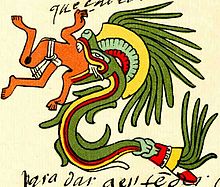
Chinese (Loong):
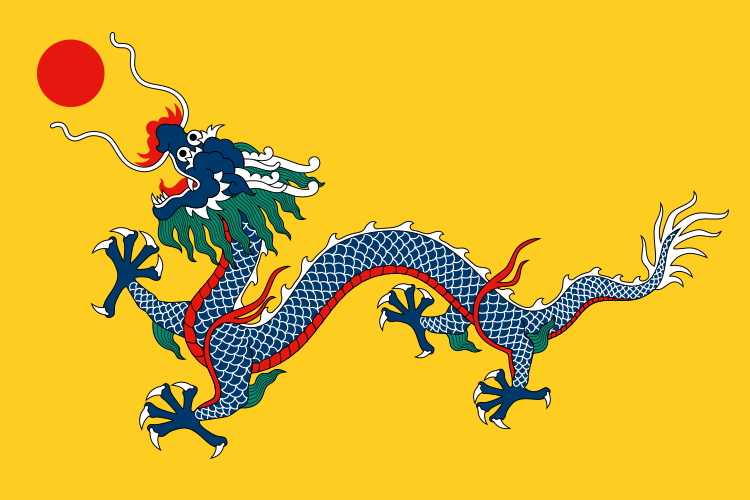
Middle-eastern (Yaldabaoth):
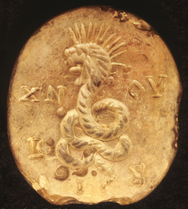
Aztec (Quetzalcoatl):

Chinese (Loong):

Middle-eastern (Yaldabaoth):

What is truly odd is that all these ancient cultures that supposedly never had trans oceanic travel or contact with each other all have legends about
winged serpents or dragons. Why is that?
a reply to: ColoradoTemplar
or it is allegory for solar events
like eclipses
you have to remember alot of these old civilizations worshiped the sun and seasons
or it is allegory for solar events
like eclipses
you have to remember alot of these old civilizations worshiped the sun and seasons
spam
edit on 1.20.2022 by Zarniwoop because: (no reason given)
new topics
-
Federal law trumps state and local law every time
Social Issues and Civil Unrest: 10 hours ago
top topics
-
Federal law trumps state and local law every time
Social Issues and Civil Unrest: 10 hours ago, 16 flags
active topics
-
Federal law trumps state and local law every time
Social Issues and Civil Unrest • 28 • : xuenchen -
Well, here we go red lines crossed Biden gives the go ahead to use long range missiles
World War Three • 390 • : Freeborn -
Anyone like the Scorpions?
Music • 21 • : belkide -
Comcast dumping MSNBC
Mainstream News • 36 • : Kaiju666 -
Post A Funny (T&C Friendly) Pic Part IV: The LOL awakens!
General Chit Chat • 7831 • : DBCowboy -
DOJ Special Counsel Robert HUR Says JOE BIDEN Can Be ARRESTED After Jan 20th 2025.
Above Politics • 25 • : Kaiju666 -
-@TH3WH17ERABB17- -Q- ---TIME TO SHOW THE WORLD--- -Part- --44--
Dissecting Disinformation • 3380 • : RelSciHistItSufi -
Remember These Attacks When President Trump 2.0 Retribution-Justice Commences.
2024 Elections • 94 • : xuenchen -
I thought Trump was the existential threat?
World War Three • 77 • : EyeoftheHurricane -
The Acronym Game .. Pt.4
General Chit Chat • 993 • : JJproductions
20
